Castile (historical region)
| Castile Castilla | |
|---|---|
| Historical region | |
 The territory of Castile in 2 possible interpretations | |
| Country | Spain |
| Elevation | 800 m (2,600 ft) |
Castile (/kæˈstiːl/; Spanish: Castilla [kasˈtiʎa]) is a Spanish historical region of vague borders, which is the result of a gradual merge of the Kingdom of Castile with its neighbours to become the Crown of Castile and later the Kingdom of Spain when united with the Crown of Aragon and the Kingdom of Navarre. The historical capital and the origin is situated on Burgos. In modern-day Spain, it is usually considered to comprise a part of the autonomous community of Castile and León in the north-west, and Castile–La Mancha and Madrid in the center and the central-south-west of the country, sometimes including Cantabria and La Rioja in the north as well, for historical reasons. However, there are different versions about the exact boundaries of Castile, and since it lacks modern day official recognition, it has no official borders. It was traditionally divided between Old Castile, which from 1833 was Cantabria, La Rioja and the eastern half of Castile and León and New Castile, which was Castile–La Mancha and the Community of Madrid. Modern Spanish monarchs are numbered according to the system of Castile.
Castile's name is thought to mean "land of castles", in reference to the castles built in the area to consolidate the Christian Reconquest from the Moors. The Spanish word for castle is actually castillo.
History
Historically, the Castilian Kingdom and people were considered to be the main architects of the Spanish State by a process of expansion to the South against the Muslims and of marriages, wars, assimilation, and annexation of their smaller Eastern and Western neighbours. From the advent of the Bourbon Monarchy following the War of the Spanish Succession until the arrival of parliamentary democracy in 1977, the Castilian language was the only one with official status in the Spanish state.
Originally an eastern county of the kingdom of León, in the 11th century Castile became an independent realm with its capital at Burgos. The County of Castile, which originally included most of Burgos and parts of Vizcaya, Álava, Cantabria and La Rioja.,[1] became the leading force in the northern Christian states' 800-year Reconquista ("reconquest") of central and southern Spain from the Muslim rulers who had dominated most of the peninsula since the early 8th century.
The capture of Toledo in 1085 added New Castile to the crown's territories, and the battle of Las Navas de Tolosa (1212) heralded the Muslim loss of most of southern Spain. León was finally reunited with Castile in 1230, and the following decades saw the capture of Córdoba (1236), Murcia (1243) and Seville (1248). By the Treaty of Alcaçovas with Portugal on March 6, 1460, the ownership of the Canary Islands was transferred to Castile.
The dynastic union of Castile and Aragon in 1469, when Ferdinand II of Aragon wed Isabella I of Castile, would eventually lead to the formal creation of Spain as a single entity in 1516 when their grandson Charles V assumed both thrones. See List of Spanish monarchs and Kings of Spain family tree.
Geography
At the present time there are two nominally Castilian autonomous communities in Spain, as they hold the toponym in their own official name: Castile and Leon and Castile-La Mancha. A third, the Community of Madrid is considered also Castilian, by its geographic enclosure and, above all, by the statements of its Statute of Autonomy, since its autonomic process originated by national interest and not by popular disaffection with Castile.[2]
Other territories in the former Crown of Castile are left out for different reasons. In fact, the territory of the Castilian Crown actually comprised all other autonomous communities within Spain with the exception of Aragon, Balearic Islands, Valencia and Catalonia, which all belonged to the late Crown of Aragon, and Navarre, heir of the older Kingdom of the same name. Castile was divided between Old Castile in the north, which was called so because it was where the Kingdom of Castile was formed, and New Castile, which was called the Kingdom of Toledo in the Middle Ages. The Leonese region, while being in the Crown of Castile from 1230 was considered a region in its own right from medieval times on par with the two Castiles and appeared on maps alongside Old Castile until the two joined into one region, Castilla-y-Leon in the 1980s. However, in 1833, Spain was organised into administrative regions with specific official borders.
Two non administrative Castilian regions existed from 1833 to 1982: Old Castile, including Santander (autonomous community of Cantabria since 1981), Burgos, Logroño (autonomous community of La Rioja since 1982), Palencia, Valladolid, Soria, Segovia and Ávila, and New Castile consisting of Madrid (autonomous community of Madrid since 1983), Guadalajara, Cuenca, Toledo and Ciudad Real.
Maps
-
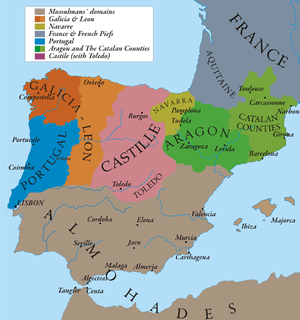
Castile in 1210
-
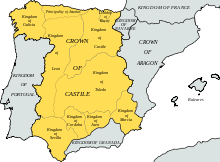
Kingdoms of the Crown of Castile in 1400. Note how Old Castile was called Kingdom of Castile and New Castile was called the Kingdom of Toledo.
-
.jpg)
Castile and other Iberian regions in 1770
-

Old Castile and New Castile (1833 until the early 1980s).
-

Self-defined Castilian autonomous communities (since the 1980s). The Leonese region joined with Old Castile, while Cantabria, La Rioja and Madrid became administrative regions of their own.
Flags
-

Older banner of the Kingdom of Castile.
-
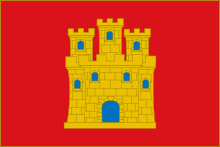
Historic Castilian flag. This flag is now used by Castilian regionalists.
-
.svg.png)
Historic flag of the Crown of Castile. This shows the union of the Kingdom of Castile with the Kingdom of Leon to form the Crown of Castile.
-
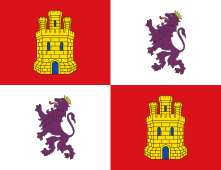
Flag of the autonomous community of Castilla y León.
-

Flag of the autonomous community of Castile–La Mancha.
-
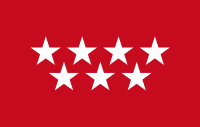
Flag of the autonomous community of Madrid. The red color symbolizes the connection to both Castiles.[1]
-
.svg.png)
Flag used by Castilian Nationalists.
-
.svg.png)
Flag used by Castilian Left followers.
- ^ El escudo y la bandera. Memoria y diseños de los símbolos de la Comunidad Autónoma de Madrid., page 5. Santiago Amón, published by Comunidad de Madrid. ISBN 84-500-9765-7
Coats of arms
-
.svg.png)
Heraldic Sign of the Kingdom of Castile between 1171-1214
-
.svg.png)
Historic coat of arms of the Kingdom of Castile between 1214-1230
-

Coat of Arms of Castile with the Royal Crest
-
.svg.png)
Historic coat of arms of the Crown of Castile between 1230-1284.
This shows the union of the Kingdom of Castile with the Kingdom of Leon to form the Crown of Castile. -
.svg.png)
Historic coat of arms of the Crown of Castile between 1284-c.1400
-
.svg.png)
Historic coat of arms of the Crown of Castile between c.1400-1500
-
.svg.png)
Historic coat of arms of the Crown of Castile between 1500-1705
-

Coat of arms of the autonomous community of Castile and León
-

Coat of arms of the autonomous community of Castile–La Mancha
-
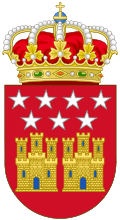
Coat of arms of the Community of Madrid. The two castles represent the two Castilian communities and Madrid as their union
Language
The language of Castile emerged as the primary language of Spain—known to many of its speakers as castellano and in English sometimes as Castilian, but generally as Spanish. See Names given to the Spanish language.
Castilian identity and cultural expansion
.jpg)

(Latin was de jure around Iberian peninsula in that time).
Castilians are defined as a community with a shared culture and history. Their origin is, as well as most of other parts of the Spain, a heterogeneous mixture of Celtiberian, Roman, and Germanic peoples (see also Spanish people). Thus, it is not correct to establish a strict common origin, but a common cultural identity. Over time, most Castilians have mixed with other Spaniards due to their past political dominance, and present-day cultural dominance. Castilians and their cultural influence spread throughout the entire plateau of central Spain during the Reconquista, carried out principally by the Kingdom of Toledo which was renamed New Castile. Castilian ethnicity is the product of the conquest, by a small kingdom in northern Spain, of vast tracts of sparsely populated lands (the central "mesetas"). These lands were populated, during the reconquest, by peoples from all over the peninsula, even from southern Spain (see exile of Mozarabs from Al Andalus and even the dispersal of Moriscos from Granada in the 16th century).
The Castilian language, now usually known as "Spanish", gradually became the main language of Spain; it is still frequently called "Castilian" in Spain. At present, Castilians are known as the inhabitants of those regions of Spain where there is no regional identity which conflicts with that of Castilians. The Castilian territories roughly coincide with the plateaus of north-central Spain, historically sparsely populated harsh highlands.
Castilian identity is ambiguous: since Castilian nationalism was the first to have been suppressed by the Spanish Crown during the revolt and war of the Castilian War of the Communities against the Spanish Monarchy, between 1520 and 1521, a strong sense of identity cannot be found in Castilians and there are differences about what can be considered Castile.
Castilian identity is thus excluded from the historical nationalities of Spain such as Catalonia, Galicia and the Basque Country, but also other autonomous communities of Spain which due to historical reasons have their own strong identities, such as Andalusia, Asturias, Aragon, Balearic Islands, Canary Islands and the Valencian Community. Both Andalusia and the Canary Islands experienced an early Castilian colonisation and subsequent immigration, but the survival and absorption of by the large local populations allowed for characteristics and separate identities particular to those regions to survive. Certain regions are not considered Castilian, such as Valencia and the Balearic Islands because historically they belong to the Crown of Aragon and because their local languages are Catalan dialects. Galicians are not considered to be Castilian, although the former Kingdom of Galicia was annexed by the Crown of Castile.
Their language, Galician, is akin to Portuguese, and they possess a local culture and identity. Navarre, a historical kingdom in its own right, has a culture that is mainly Basque in the north and closer to that of Old Castile in the south, especially in La Rioja and Aragon, in the south. Extremadura, a region in western Spain, is usually not considered to be Castilian; it has a strong link to neighbouring Andalusia. Murcia has always been a region of its own. The Leonese region was a separate region before democracy in the 1970s, and had its own language, Leonese, which is moribund. However, Castile and León (Spanish: Castilla y León) had the Spanish conjunction y ('and') inserted as the León region is not considered to be in Castile (the north half) but joint with it in this autonomous community.
Some Leonese want Castile and León to be dissolved and become an autonomous community in its own right as the Leonese Country. Cantabria was previously considered as part of Old Castile, but they have their own identity and had achieved independence from Castile in the 1970s and are now a comunidad autonoma in their own right. Madrid had been in New Castile until the 1970s and has traditionally been considered Castilian. However, its status as the capital of Spain, meant that it gained its own autonomous community. Also, its people are not all Castilian as there have been immigration from other regions in Spain and indeed the world. In terms of cultural identity, there is a divide and controversy. Older Madrid people as well as Castilians nationalist in the region consider their city to be in Castile (cultural identity). Younger Madrid people, look at the modern reality of the administration, and do not consider it to be in Castile, as there is no reference to it in the name or the symbols of the autonomous community. However, the folk culture in the Madrid region is Castilian, even though the city itself has its own folklore, the chotis. As for La Mancha, they are still in Castile as their autonomous community is called Castile–La Mancha. However, their cultural identity focuses on the La Mancha rather than on the Castile. They have their own identity even though they are recognised as fully Castilian, for example, they had no language of their own, unlike, León.
See also
- Castilian people
- Old Castile
- New Castile
- Crown of Castile
- Early history of the Kingdom of León
- Later history of Spain
- List of Castile Kings
- Castile soap
- Music of Castile and Leon
- Two places in the United States have been named after this kingdom: Village of Castile and Town of Castile. Both are located in the state of New York.
References
- ↑ Martínez Díez, Gonzalo (2005). El Condado de Castilla, (711-1038) - La Historia frente a la Leyenda. Marcial Pons, Ediciones de Historia. p. 819. ISBN 84-9718-275-8.
- ↑ "En efecto, la negativa de las provincias castellano-manchegas a la integración de Madrid en su región, su falta de entidad regional histórica, su existencia como Área Metropolitana y, el ser la Villa de Madrid la capital del Estado significaron que la provincia madrileña partiese de cero en el camino de su autonomía, sin trámites intermedios, sin régimen preautonómico". "La falta de entidad regional histórica de Madrid, hizo preciso acudir a la vía del artículo 144, apartado a) de la Norma Fundamental: "Las Cortes Generales, mediante ley orgánica, podrán por motivos de interés nacional: a)Autorizar la constitución de una Comunidad Autónoma cuando su ámbito territorial no supere el de una provincia y no reúna las condiciones del apartado 1 del artículo 143." Blanca Cid. Directora de Gestión Parlamentaria de la Asamblea de la Comunidad de Madrid. (2003). "Sinopsis del Estatuto de la Comunidad de Madrid" (in Spanish). Retrieved 2009-12-26.